JAVA程序设计教程(第七版)第四章
- 格式:pdf
- 大小:125.56 KB
- 文档页数:18
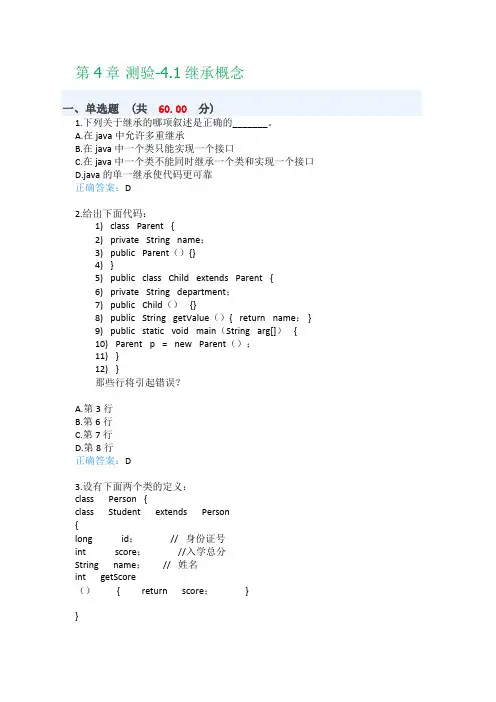
第4章测验-4.1继承概念一、单选题(共60.00分)1.下列关于继承的哪项叙述是正确的_______。
A.在java中允许多重继承B.在java中一个类只能实现一个接口C.在java中一个类不能同时继承一个类和实现一个接口D.java的单一继承使代码更可靠正确答案:D2.给出下面代码:1) class Parent {2) private String name;3) public Parent(){}4) }5) public class Child extends Parent {6) private String department;7) public Child() {}8) public String getValue(){ return name; }9) public static void main(String arg[]) {10) Parent p = new Parent();11) }12) }那些行将引起错误?A.第3行B.第6行C.第7行D.第8行正确答案:D3.设有下面两个类的定义:class Person {class Student extends Person{long id; // 身份证号int score; //入学总分String name; // 姓名int getScore() { return score; }}}问:类Person和类Student的关系是()。
A.包含关系B.继承关系(内部类继承了外部类)C.关联关系D.无关系,上述类定义有语法错误正确答案:B二、判断题(共40.00分)1.构造方法不能被继承。
A.正确B.错误正确答案:A2.一个子类可以重新定义从父类那里继承来的同名方法,而且允许它们有不同的返回值类型。
A.正确B.错误正确答案:B第4章测验-4.2成员变量/方法一、单选题(共33.20分)1.看下面一段程序:class Aclass{void go(){System.out.println(“Aclass“);}}public class Bclass extends Aclass{void go{System.out.println(“Bclass“);}public static void main(String args[]){Aclass a=new Aclass();Aclass a1=new Bclass();a.go();a1.go();}以上程序运行结果是:A.Aclass AclassB.Bclass BclassC.Aclass BclassD.Bclass Aclass正确答案:C2.在Java中,以下关于方法重载和方法重定义描述正确的是?A.方法重载和方法的重定义实现的功能相同B.方法重载出现在父子关系中,方法重定义是在同一类中C.方法重载的返回值类型必须一致,参数项必须不同D.方法重定义的返回值类型必须相同或相容。
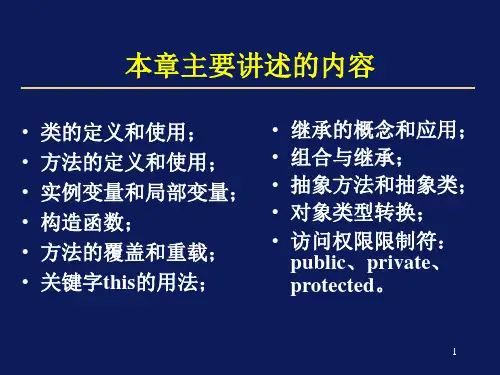

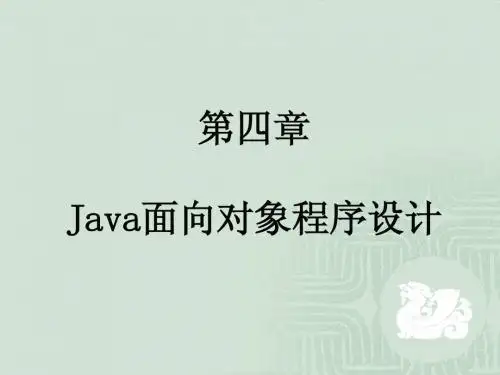
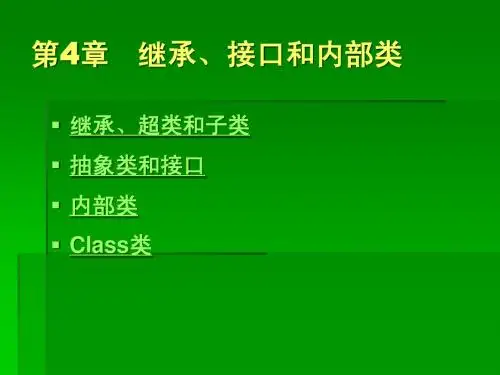
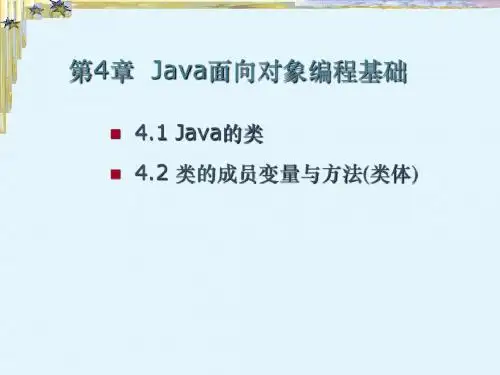
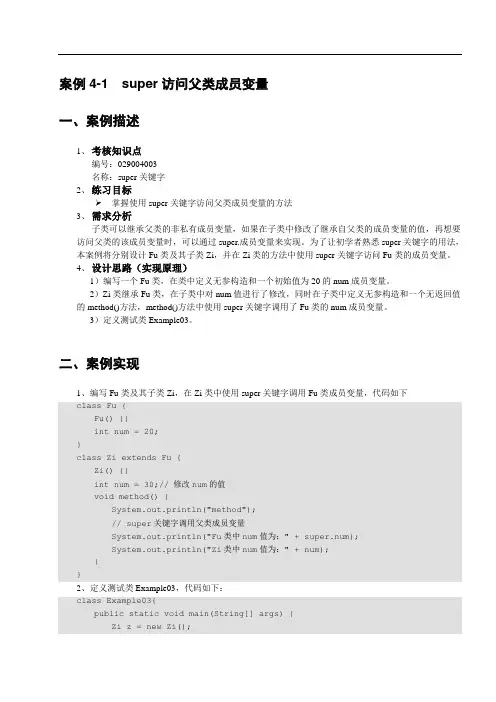
案例4-1 super访问父类成员变量一、案例描述1、考核知识点编号:029004003名称:super关键字2、练习目标➢掌握使用super关键字访问父类成员变量的方法3、需求分析子类可以继承父类的非私有成员变量,如果在子类中修改了继承自父类的成员变量的值,再想要访问父类的该成员变量时,可以通过super.成员变量来实现。
为了让初学者熟悉super关键字的用法,本案例将分别设计Fu类及其子类Zi,并在Zi类的方法中使用super关键字访问Fu类的成员变量。
4、设计思路(实现原理)1)编写一个Fu类,在类中定义无参构造和一个初始值为20的num成员变量。
2)Zi类继承Fu类,在子类中对num值进行了修改,同时在子类中定义无参构造和一个无返回值的method()方法,method()方法中使用super关键字调用了Fu类的num成员变量。
3)定义测试类Example03。
二、案例实现1、编写Fu类及其子类Zi,在Zi类中使用super关键字调用Fu类成员变量,代码如下class Fu {Fu() {}int num = 20;}class Zi extends Fu {Zi() {}int num = 30;// 修改num的值void method() {System.out.println("method");// super关键字调用父类成员变量System.out.println("Fu类中num值为:" + super.num);System.out.println("Zi类中num值为:" + num);}}2、定义测试类Example03,代码如下:class Example03{public static void main(String[] args) {Zi z = new Zi();z.method();}}运行结果如图4-3所示。
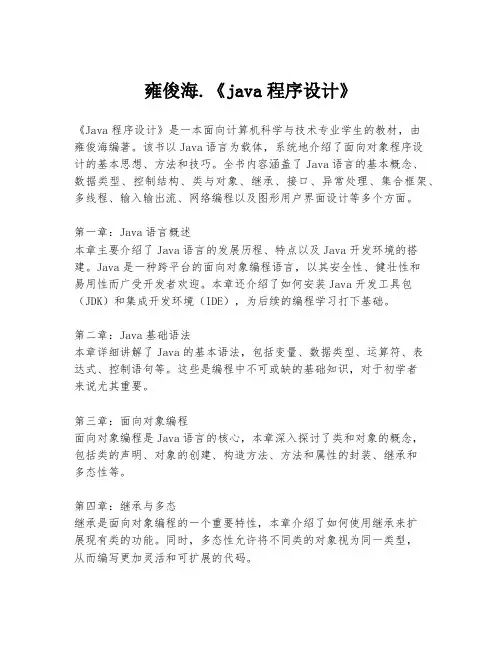
雍俊海.《java程序设计》《Java程序设计》是一本面向计算机科学与技术专业学生的教材,由雍俊海编著。
该书以Java语言为载体,系统地介绍了面向对象程序设计的基本思想、方法和技巧。
全书内容涵盖了Java语言的基本概念、数据类型、控制结构、类与对象、继承、接口、异常处理、集合框架、多线程、输入输出流、网络编程以及图形用户界面设计等多个方面。
第一章:Java语言概述本章主要介绍了Java语言的发展历程、特点以及Java开发环境的搭建。
Java是一种跨平台的面向对象编程语言,以其安全性、健壮性和易用性而广受开发者欢迎。
本章还介绍了如何安装Java开发工具包(JDK)和集成开发环境(IDE),为后续的编程学习打下基础。
第二章:Java基础语法本章详细讲解了Java的基本语法,包括变量、数据类型、运算符、表达式、控制语句等。
这些是编程中不可或缺的基础知识,对于初学者来说尤其重要。
第三章:面向对象编程面向对象编程是Java语言的核心,本章深入探讨了类和对象的概念,包括类的声明、对象的创建、构造方法、方法和属性的封装、继承和多态性等。
第四章:继承与多态继承是面向对象编程的一个重要特性,本章介绍了如何使用继承来扩展现有类的功能。
同时,多态性允许将不同类的对象视为同一类型,从而编写更加灵活和可扩展的代码。
第五章:接口与内部类接口提供了一种定义方法规范的方式,而内部类则允许在一个类中定义另一个类。
本章探讨了接口和内部类的使用场景和实现方法。
第六章:异常处理Java提供了一套异常处理机制,使得程序在遇到错误时能够更加优雅地进行处理。
本章介绍了异常的分类、捕获和处理方式。
第七章:集合框架Java集合框架是Java语言中用于存储数据集合的一套接口和类。
本章详细介绍了集合框架中的各种数据结构,如List、Set、Map等,以及它们的使用方式。
第八章:多线程编程多线程是现代程序设计中的一个重要概念,Java提供了丰富的多线程支持。
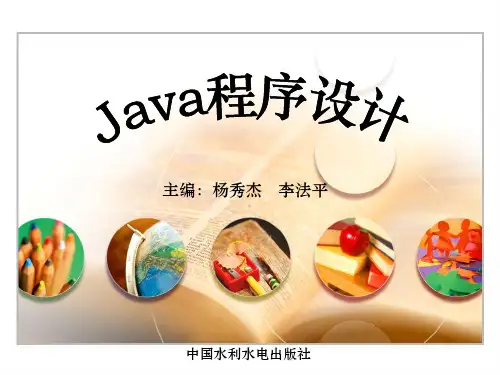

Java Web 程序设计教程(范立锋、林果园编著)第4章 SQL与JDBC 习题答案1.简述SQL的组成部分。
SQL语言由以下3部分组成,分别是:数据库模式定义语言(DDL):CREATE、DROP、ALTER等语句。
数据操纵语言(DML):INSERT、UPDATE、DELETE、SELECT语句。
数据控制语言:GRANT、REVOKE、COMMIT、ROLLBACK等语句。
2.简述JDBC的执行步骤。
①加载JDBC驱动程序通过静态类Class类加载数据库驱动。
②取得数据库连接通过DriverManager类中的getConnection()获取数据库的连接对象Connection③执行各种SQL语句将Connection对象转换成Statement对象,通过该对象的executeUpdate()执行添加、修改以及删除的SQL语句。
④获取查询结果将Connection对象转换成Statement对象,通过该对象的executeQuery()执行查询的SQL语句,该方法返回ResultSet对象。
⑤关闭数据库连接通过Connection对象的close()方法关闭数据库连接,并抛出异常。
3.Statement对象可以处理哪些类型的SQL语句,处理这些SQL语句的主要方法是什么?Statement接口的executeUpdate(String sql)方法将执行添加(insert)、修改(update)和删除(delete)的SQL语句,执行成功后,将返回一个int型数值,该数值为影响数据库记录的行数。
该接口还可以通过executeQuery()方法查询的SQL语句。
4.PreparedStatement对象可以处理哪些类型的SQL语句,处理这些SQL语句的主要方法是什么?PreparedStatement接口的executeUpdate(String sql)方法将执行添加(insert)、修改(update)和删除(delete)的SQL语句,执行成功后,将返回一个int型数值,该数值为影响数据库记录的行数。

import java.util.*;public class Person{private String name;private char sex;private int year,month;public Person( ){}public Person(String nm,char sx,int y,int m) {name=nm;sex=sx;year=y;month=m;}public void printPerson( ) {Calendar now=Calendar.getInstance();int age=now.get(Calendar.YEAR)-year;System.out.println("Name: "+name+",Sex: "+sex+", Age: "+age);}public static void main(String args[]){Person pe1=new Person("Tom",'m',1980,10);pe1.printPerson();}}2.public class Rectangle{double width,length,girth,area;public Rectangle(){};public Rectangle(double wd,double le) {width=wd;length=le;}public void setWidth(double wd) {width=wd;}public void setLength(double le) {length=le;}public double getWidth( ) {return width;}public double getLength( ) {return length;}public double girth(){return 2*(width+length);public double area(){return width*length;}public void printRectangle(){System.out.println("Width="+width+" ,Length="+length);}public static void main(String args[]){Rectangle re1=new Rectangle(10,20);Rectangle re2=new Rectangle();re2.setWidth(3);re2.setLength(4);re1.printRectangle();System.out.println("Girth="+re1.girth()+",Area="+re1.area());re2.printRectangle();System.out.println("Girth="+re2.girth()+",Area="+re2.area());}}3.public class Matrix{private int mx[][],m,n;public Matrix(int r,int c) {m=r;n=c;mx=new int[m][n];iniMatrix();}public Matrix(){m=3;n=3;mx=new int[3][3];iniMatrix();}public void iniMatrix(){int i,j;for(i=0;i<=m-1;i++)for(j=0;j<=n-1;j++)mx[i][j]=(int)(Math.random()*100);}public void tranMatrix(){int i,j,t;int mt[][]=new int[m][n];for(i=0;i<=m-1;i++)for(j=0;j<=n-1;j++)mt[i][j]=mx[i][j];t=m;m=n;n=t;mx=new int[m][n];for(i=0;i<=m-1;i++)for(j=0;j<=n-1;j++)mx[i][j]=mt[j][i];}public void printMatrix(){int i,j;for(i=0;i<=m-1;i++){for(j=0;j<=n-1;j++)System.out.print(" "+mx[i][j]);System.out.println();}}public void addMatrix(Matrix b) {int i,j;for(i=0;i<=m-1;i++)for(j=0;j<=n-1;j++)mx[i][j]=mx[i][j]+b.mx[i][j];}public static void main(String args[]){Matrix ma=new Matrix(4,3);Matrix mb=new Matrix(4,3);System.out.println("The matrix_A:");ma.printMatrix();System.out.println("The matrix_B:");mb.printMatrix();System.out.println("Matrix_A + Matrix_B:");ma.addMatrix(mb);ma.printMatrix();System.out.println("Transpose Matrix_B:");mb.tranMatrix();mb.printMatrix();}}4.public class Substring{public static void main(String args[]){String str1=new String("addActionListener");String str2=new String("Action");int n;n=str1.indexOf(str2);if(n>=0){System.out.println("String_2 is in String_1");System.out.println("The substring before String_2 is "+str1.substring(0,n));System.out.println("The substring behind String_2 is "+str1.substring(n+str2.length( )));}}}五、写出程序运行后的结果1.2.。
第4章 SWT图形用户界面本章要点1.SWT程序开发步骤。
2.SWT常用组件的使用。
3.SWT的布局。
4.SWT的事件处理。
5.SWT Designer简介。
本章难点1.SWT常用组件的使用。
2.SWT的布局。
3.SWT的事件处理。
4.1SWT/JFace简介SWT(Standard Widget Toolkit)即标准小窗口工具箱,是IBM公司推出的一种在Eclipse 中使用的集成开发环境,SWT提供可移植的API,并与底层本机OS GUI平台紧密集成,它是一个与本地窗口系统集成在一起的小部件集和图形库。
SWT由JNI(Java Native Interface,Java本机接口)调用操作系统的内部API,因此运行速度快,能够获得与操作系统的内部应用程序相同的外观。
JFace是一个用户界面工具箱,也是一个易用、功能强大的图形包,它简化了常见的图形用户界面的编程任务。
SWT和JFace都是Eclipse平台上的主要组件。
JFace是在SWT的基础上创建的,但JFace并不能完全覆盖SWT的功能,JFace和SWT的关系如图4.1所示。
由于JFace的功能更强大,因此做图形界面开发时一般优先选用JFace。
图4.1 JFace和SWT的关系4.1.1 SWT程序开发步骤在eclipse的plugins目录下,找到文件org.eclipse.swt.win32.win32.x86_3.2.1.v3235.jar,文件名中中3.2.1是eclipse的版本号,v3235是SWT的序列号,不同的eclipse版本这两个数字也不同。
在DOS状态下,用jar命令将该文件解压,命令格式如下:jar xf org.eclipse.swt.win32.win32.x86_3.2.1.v3235.jar该命令将指定的文件org.eclipse.swt.win32.win32.x86_3.2.1.v3235.jar解压到当前目录下。
Copyright ©2012 Pearson Education, Inc.Chapter 4Writing ClassesJava Software SolutionsFoundations of Program DesignSeventh EditionJohn Lewis William LoftusWriting Classes•We've been using predefined classes from the Java API. Now we will learn to write our own classes.•Chapter 4 focuses on:–class definitions –instance data–encapsulation and Java modifiers–method declaration and parameter passing –constructors–graphical objects –events and listeners –buttons and text fieldsCopyright ©2012 Pearson Education, Inc.OutlineAnatomy of a Class Encapsulation Anatomy of a Method Graphical Objects Graphical User Interfaces Buttons and Text FieldsCopyright ©2012 Pearson Education, Inc.Writing Classes•The programs we’ve written in previous examples have used classes defined in the Java standard class library•Now we will begin to design programs that rely on classes that we write ourselves•The class that contains the main method is just the starting point of a program•True object-oriented programming is based on defining classes that represent objects with well-defined characteristics and functionalityCopyright ©2012 Pearson Education, Inc.Examples of Classes Copyright ©2012 Pearson Education, Inc.Classes and Objects•Recall from our overview of objects in Chapter 1 that an object has state and behavior •Consider a six-sided die (singular of dice)–It’s state can be defined as which face is showing –It’s primary behavior is that it can be rolled•We represent a die by designing a class called Die that models this state and behavior–The class serves as the blueprint for a die object•We can then instantiate as many die objects as we need for any particular programCopyright ©2012 Pearson Education, Inc.Classes• A class can contain data declarations and method declarationsint size, weight;char category;Data declarationsMethod declarationsCopyright ©2012 Pearson Education, Inc.Classes•The values of the data define the state of an object created from the class•The functionality of the methods define the behaviors of the object•For our Die class, we might declare an integer called faceValue that represents the current value showing on the face•One of the methods would “roll”the die by setting faceValue to a random number between one and sixCopyright ©2012 Pearson Education, Inc.Classes•We’ll want to design the Die class so that it is a versatile and reusable resource•Any given program will probably not use all operations of a given class •See RollingDice.java •See Die.javaCopyright ©2012 Pearson Education, Inc.Copyright ©2012 Pearson Education, Inc.//********************************************************************// RollingDice.java Author: Lewis/Loftus //// Demonstrates the creation and use of a user-defined class.//********************************************************************public class RollingDice {//-----------------------------------------------------------------// Creates two Die objects and rolls them several times.//-----------------------------------------------------------------public static void main (String[] args){Die die1, die2;int sum;die1 = new Die();die2 = new Die();die1.roll();die2.roll();System.out.println ("Die One: " + die1 + ", Die Two: " + die2);continueCopyright ©2012 Pearson Education, Inc.continuedie1.roll();die2.setFaceValue(4);System.out.println ("Die One: " + die1 + ", Die Two: " + die2);sum = die1.getFaceValue() + die2.getFaceValue();System.out.println ("Sum: " + sum);sum = die1.roll() + die2.roll();System.out.println ("Die One: " + die1 + ", Die Two: " + die2);System.out.println ("New sum: " + sum);}}Copyright ©2012 Pearson Education, Inc.continuedie1.roll();die2.setFaceValue(4);System.out.println ("Die One: " + die1 + ", Die Two: " + die2);sum = die1.getFaceValue() + die2.getFaceValue();System.out.println ("Sum: " + sum);sum = die1.roll() + die2.roll();System.out.println ("Die One: " + die1 + ", Die Two: " + die2);System.out.println ("New sum: " + sum);}}Sample RunDie One: 5, Die Two: 2Die One: 1, Die Two: 4Sum: 5Die One: 4, Die Two: 2New sum: 6Copyright ©2012 Pearson Education, Inc.//********************************************************************// Die.java Author: Lewis/Loftus //// Represents one die (singular of dice) with faces showing values // between 1 and 6.//********************************************************************public class Die {private final int MAX = 6; // maximum face valueprivate int faceValue; // current value showing on the die//-----------------------------------------------------------------// Constructor: Sets the initial face value.//-----------------------------------------------------------------public Die(){faceValue = 1;}continueCopyright ©2012 Pearson Education, Inc.continue//-----------------------------------------------------------------// Rolls the die and returns the result.//-----------------------------------------------------------------public int roll(){faceValue = (int )(Math.random() * MAX) + 1;return faceValue;}//-----------------------------------------------------------------// Face value mutator.//-----------------------------------------------------------------public void setFaceValue (int value){faceValue = value;}//-----------------------------------------------------------------// Face value accessor.//-----------------------------------------------------------------public int getFaceValue(){return faceValue;}continueCopyright ©2012 Pearson Education, Inc.continue//-----------------------------------------------------------------// Returns a string representation of this die.//-----------------------------------------------------------------public String toString(){String result = Integer.toString(faceValue);return result;}}The Die Class•The Die class contains two data values–a constant MAX that represents the maximum face value –an integer faceValue that represents the current face value•The roll method uses the random method of the Math class to determine a new face value •There are also methods to explicitly set and retrieve the current face value at any timeCopyright ©2012 Pearson Education, Inc.The toString Method•It's good practice to define a toString method for a class•The toString method returns a character string that represents the object in some way•It is called automatically when an object isconcatenated to a string or when it is passed to the println method•It's also convenient for debugging problemsCopyright ©2012 Pearson Education, Inc.Constructors•As mentioned previously, a constructor is used to set up an object when it is initially created • A constructor has the same name as the class •The Die constructor is used to set the initial face value of each new die object to one•We examine constructors in more detail later in this chapterCopyright ©2012 Pearson Education, Inc.Data Scope•The scope of data is the area in a program in which that data can be referenced (used)•Data declared at the class level can be referenced by all methods in that class•Data declared within a method can be used only in that method•Data declared within a method is called local data•In the Die class, the variable result is declared inside the toString method --it is local to that method and cannot be referenced anywhere elseCopyright ©2012 Pearson Education, Inc.Instance Data• A variable declared at the class level (such as faceValue) is called instance data•Each instance (object) has its own instance variable • A class declares the type of the data, but it does not reserve memory space for it•Each time a Die object is created, a new faceValue variable is created as well•The objects of a class share the method definitions, but each object has its own data space•That's the only way two objects can have different statesCopyright ©2012 Pearson Education, Inc.Instance Data•We can depict the two Die objects from the RollingDice program as follows:die15faceValuedie22faceValueEach object maintains its own faceValuevariable, and thus its own stateCopyright ©2012 Pearson Education, Inc.UML Diagrams•UML stands for the Unified Modeling Language•UML diagrams show relationships among classes and objects•A UML class diagram consists of one or more classes, each with sections for the class name, attributes (data), and operations (methods)•Lines between classes represent associations• A dotted arrow shows that one class uses the other (calls its methods)Copyright ©2012 Pearson Education, Inc.UML Class Diagrams• A UML class diagram for the RollingDice program:RollingDice main (args : String[]) : voidDiefaceValue : introll() : intsetFaceValue (int value) : voidgetFaceValue() : inttoString() : StringQuick CheckCopyright ©2012 Pearson Education, Inc.What is the relationship between a class and anobject?Quick CheckCopyright ©2012 Pearson Education, Inc.What is the relationship between a class and an object?A class is the definition/pattern/blueprint of an object. It defines the data that will be managed by an object but doesn't reserve memory space for it. Multiple objects can be created from a class, and each object has its own copy of the instance data.Quick CheckCopyright ©2012 Pearson Education, Inc.Where is instance data declared?What is the scope of instance data?What is local data?Quick CheckCopyright ©2012 Pearson Education, Inc.Where is instance data declared?What is the scope of instance data?What is local data?At the class level.It can be referenced in any method of the class.Local data is declared within a method, and is only accessible in that method.OutlineAnatomy of a Class Encapsulation Anatomy of a Method Graphical Objects Graphical User Interfaces Buttons and Text FieldsCopyright ©2012 Pearson Education, Inc.Encapsulation•We can take one of two views of an object:–internal -the details of the variables and methods of the class that defines it–external -the services that an object provides and how the object interacts with the rest of the system•From the external view, an object is anencapsulated entity, providing a set of specific services•These services define the interface to the objectCopyright ©2012 Pearson Education, Inc.Encapsulation•One object (called the client ) may use another object for the services it provides•The client of an object may request its services (call its methods), but it should not have to be aware of how those services are accomplished •Any changes to the object's state (its variables) should be made by that object's methods •We should make it difficult, if not impossible, for a client to access an object’s variables directly •That is, an object should be self-governingCopyright ©2012 Pearson Education, Inc.Encapsulation•An encapsulated object can be thought of as a black box--its inner workings are hidden from the client •The client invokes the interface methods and they manage the instance dataMethodsDataClientCopyright ©2012 Pearson Education, Inc.Visibility Modifiers•In Java, we accomplish encapsulation through the appropriate use of visibility modifiers• A modifier is a Java reserved word that specifies particular characteristics of a method or data•We've used the final modifier to define constants•Java has three visibility modifiers: public, protected, and private•The protected modifier involves inheritance, which we will discuss laterCopyright ©2012 Pearson Education, Inc.Visibility Modifiers•Members of a class that are declared with public visibility can be referenced anywhere•Members of a class that are declared with private visibility can be referenced only within that class •Members declared without a visibility modifier have default visibility and can be referenced by any class in the same package•An overview of all Java modifiers is presented in Appendix ECopyright ©2012 Pearson Education, Inc.Visibility Modifiers•Public variables violate encapsulation because they allow the client to modify the values directly•Therefore instance variables should not be declared with public visibility•It is acceptable to give a constant public visibility, which allows it to be used outside of the class •Public constants do not violate encapsulation because, although the client can access it, its value cannot be changedCopyright ©2012 Pearson Education, Inc.Visibility Modifiers•Methods that provide the object's services are declared with public visibility so that they can be invoked by clients•Public methods are also called service methods • A method created simply to assist a service method is called a support method•Since a support method is not intended to be called by a client, it should not be declared with public visibilityCopyright ©2012 Pearson Education, Inc.Visibility Modifierspublic privateVariablesMethods Provide servicesto clientsSupport othermethods in theclassEnforceencapsulationViolateencapsulationCopyright ©2012 Pearson Education, Inc.Accessors and Mutators•Because instance data is private, a class usually provides services to access and modify data values •An accessor method returns the current value of a variable• A mutator method changes the value of a variable •The names of accessor and mutator methods take the form getX and setX , respectively, where X is the name of the value•They are sometimes called “getters”and “setters”Copyright ©2012 Pearson Education, Inc.Mutator Restrictions•The use of mutators gives the class designer the ability to restrict a client’s options to modify an object’s state• A mutator is often designed so that the values of variables can be set only within particular limits •For example, the setFaceValue mutator of the Die class should restrict the value to the valid range (1 to MAX )•We’ll see in Chapter 5 how such restrictions can be implementedCopyright ©2012 Pearson Education, Inc.Quick CheckCopyright ©2012 Pearson Education, Inc.Why was the faceValue variable declared as private in the Die class?Why is it ok to declare MAX as public in the Die class?Quick CheckCopyright ©2012 Pearson Education, Inc.Why was the faceValue variable declared as private in the Die class?Why is it ok to declare MAX as public in the Die class?By making it private, each Die object controls its own data and allows it to be modified only by the well-defined operations it provides.MAX is a constant. Its value cannot be changed. Therefore, there is no violation of encapsulation.OutlineAnatomy of a Class Encapsulation Anatomy of a Method Graphical Objects Graphical User Interfaces Buttons and Text FieldsCopyright ©2012 Pearson Education, Inc.Method Declarations•Let’s now examine methods in more detail• A method declaration specifies the code that will be executed when the method is invoked (called)•When a method is invoked, the flow of control jumps to the method and executes its code•When complete, the flow returns to the place where the method was called and continues•The invocation may or may not return a value, depending on how the method is definedCopyright ©2012 Pearson Education, Inc.myMethod();myMethodcomputeMethod Control Flow•If the called method is in the same class, only the method name is neededCopyright ©2012 Pearson Education, Inc.doIthelpMehelpMe();obj.doIt();mainMethod Control Flow•The called method is often part of another class or objectCopyright ©2012 Pearson Education, Inc.Method Header• A method declaration begins with a method headerchar calc (int num1, int num2, String message)method name return typeparameter listThe parameter list specifies the type and name of each parameterThe name of a parameter in the method declaration is called a formal parameterCopyright ©2012 Pearson Education, Inc.Method Body•The method header is followed by the method bodychar calc (int num1, int num2, String message){int sum = num1 + num2;char result = message.charAt (sum);return result;}The return expression must be consistent with the return typesum and result are local dataThey are created each time themethod is called, and are destroyed when it finishes executingCopyright ©2012 Pearson Education, Inc.The return Statement•The return type of a method indicates the type of value that the method sends back to the calling location• A method that does not return a value has a void return type• A return statement specifies the value that will be returnedreturn expression ;•Its expression must conform to the return typeCopyright ©2012 Pearson Education, Inc.Parameters•When a method is called, the actual parameters in the invocation are copied into the formal parameters in the method headerchar calc (int num1, int num2, String message){int sum = num1 + num2;char result = message.charAt (sum);return result;}ch = obj.calc (25, count, "Hello");Copyright ©2012 Pearson Education, Inc.Local Data•As we’ve seen, local variables can be declared inside a method•The formal parameters of a method create automatic local variables when the method is invoked•When the method finishes, all local variables are destroyed (including the formal parameters)•Keep in mind that instance variables, declared at the class level, exists as long as the object existsCopyright ©2012 Pearson Education, Inc.Bank Account Example•Let’s look at another example that demonstrates the implementation details of classes and methods •We’ll represent a bank account by a class named Account•It’s state can include the account number, the current balance, and the name of the owner •An account’s behaviors (or services) include deposits and withdrawals, and adding interestCopyright ©2012 Pearson Education, Inc.Driver Programs• A driver program drives the use of other, more interesting parts of a program•Driver programs are often used to test other parts of the software•The Transactions class contains a main method that drives the use of the Account class, exercising its services •See Transactions.java •See Account.javaCopyright ©2012 Pearson Education, Inc.Copyright ©2012 Pearson Education, Inc.//********************************************************************// Transactions.java Author: Lewis/Loftus //// Demonstrates the creation and use of multiple Account objects.//********************************************************************public class Transactions {//-----------------------------------------------------------------// Creates some bank accounts and requests various services.//-----------------------------------------------------------------public static void main (String[] args){Account acct1 = new Account ("Ted Murphy", 72354, 102.56);Account acct2 = new Account ("Jane Smith", 69713, 40.00);Account acct3 = new Account ("Edward Demsey", 93757, 759.32);acct1.deposit (25.85);double smithBalance = acct2.deposit (500.00);System.out.println ("Smith balance after deposit: " +smithBalance);continueCopyright ©2012 Pearson Education, Inc.continueSystem.out.println ("Smith balance after withdrawal: " +acct2.withdraw (430.75, 1.50));acct1.addInterest();acct2.addInterest();acct3.addInterest();System.out.println ();System.out.println (acct1);System.out.println (acct2);System.out.println (acct3);}}Copyright ©2012 Pearson Education, Inc.continueSystem.out.println ("Smith balance after withdrawal: " + acct2.withdraw (430.75, 1.50));acct1.addInterest();acct2.addInterest();acct3.addInterest();System.out.println();System.out.println (acct1);System.out.println (acct2);System.out.println (acct3);}}OutputSmith balance after deposit: 540.0Smith balance after withdrawal: 107.5572354 Ted Murphy $132.9069713 Jane Smith $111.5293757 Edward Demsey $785.90Copyright ©2012 Pearson Education, Inc.//********************************************************************// Account.java Author: Lewis/Loftus //// Represents a bank account with basic services such as deposit // and withdraw.//********************************************************************import java.text.NumberFormat;public class Account {private final double RATE = 0.035; // interest rate of 3.5%private long acctNumber;private double balance;private String name;//-----------------------------------------------------------------// Sets up the account by defining its owner, account number,// and initial balance.//-----------------------------------------------------------------public Account (String owner, long account, double initial){name = owner;acctNumber = account;balance = initial;}continueCopyright ©2012 Pearson Education, Inc.continue//-----------------------------------------------------------------// Deposits the specified amount into the account. Returns the // new balance.//-----------------------------------------------------------------public double deposit (double amount){balance = balance + amount;return balance;}//-----------------------------------------------------------------// Withdraws the specified amount from the account and applies // the fee. Returns the new balance.//-----------------------------------------------------------------public double withdraw (double amount, double fee){balance = balance -amount -fee;return balance;}continueCopyright ©2012 Pearson Education, Inc.continue//-----------------------------------------------------------------// Adds interest to the account and returns the new balance.//-----------------------------------------------------------------public double addInterest (){balance += (balance * RATE);return balance;}//-----------------------------------------------------------------// Returns the current balance of the account.//-----------------------------------------------------------------public double getBalance (){return balance;}//-----------------------------------------------------------------// Returns a one-line description of the account as a string.//-----------------------------------------------------------------public String toString (){NumberFormat fmt = NumberFormat.getCurrencyInstance();return (acctNumber + "\t" + name + "\t" + fmt.format(balance));}}Bank Account Exampleacct172354acctNumber102.56balance name"Ted Murphy"acct269713acctNumber40.00balancename"Jane Smith"Copyright ©2012 Pearson Education, Inc.Bank Account Example•There are some improvements that can be made to the Account class•Formal getters and setters could have been defined for all data•The design of some methods could also be more robust, such as verifying that the amountparameter to the withdraw method is positiveCopyright ©2012 Pearson Education, Inc.Constructors Revisited•Note that a constructor has no return type specified in the method header, not even void• A common error is to put a return type on aconstructor, which makes it a “regular”method that happens to have the same name as the class •The programmer does not have to define a constructor for a class•Each class has a default constructor that accepts no parametersCopyright ©2012 Pearson Education, Inc.Quick CheckCopyright ©2012 Pearson Education, Inc.How do we express which Account object's balance is updated when a deposit is made?Quick CheckCopyright ©2012 Pearson Education, Inc.How do we express which Account object's balance is updated when a deposit is made?Each account is referenced by an object reference variable:Account myAcct = new Account(…);and when a method is called, you call it through a particular object:myAcct.deposit(50);OutlineAnatomy of a Class Encapsulation Anatomy of a Method Graphical Objects Graphical User Interfaces Buttons and Text FieldsCopyright ©2012 Pearson Education, Inc.Graphical Objects•Some objects contain information that determines how the object should be represented visually •Most GUI components are graphical objects •We can have some effect on how components get drawn•We did this in Chapter 2 when we defined the paint method of an applet•Let's look at some other examples of graphical objectsCopyright ©2012 Pearson Education, Inc.Smiling Face Example•The SmilingFace program draws a face by defining the paintComponent method of a panel •See SmilingFace.java•See SmilingFacePanel.java•The main method of the SmilingFace class instantiates a SmilingFacePanel and displays it •The SmilingFacePanel class is derived from the JPanel class using inheritanceCopyright ©2012 Pearson Education, Inc.Copyright ©2012 Pearson Education, Inc.//********************************************************************// SmilingFace.java Author: Lewis/Loftus //// Demonstrates the use of a separate panel class.//********************************************************************import javax.swing.JFrame;public class SmilingFace {//-----------------------------------------------------------------// Creates the main frame of the program.//-----------------------------------------------------------------public static void main (String[] args){JFrame frame = new JFrame ("Smiling Face");frame.setDefaultCloseOperation (JFrame.EXIT_ON_CLOSE);SmilingFacePanel panel = new SmilingFacePanel();frame.getContentPane().add(panel);frame.pack();frame.setVisible(true );}}Copyright ©2012 Pearson Education, Inc.//********************************************************************// SmilingFace.java Author: Lewis/Loftus //// Demonstrates the use of a separate panel class.//********************************************************************import javax.swing.JFrame;public class SmilingFace {//-----------------------------------------------------------------// Creates the main frame of the program.//-----------------------------------------------------------------public static void main (String[] args){JFrame frame = new JFrame ("Smiling Face");frame.setDefaultCloseOperation (JFrame.EXIT_ON_CLOSE);SmilingFacePanel panel = new SmilingFacePanel();frame.getContentPane().add(panel);frame.pack();frame.setVisible(true );}}Copyright ©2012 Pearson Education, Inc.//********************************************************************// SmilingFacePanel.java Author: Lewis/Loftus //// Demonstrates the use of a separate panel class.//********************************************************************import javax.swing.JPanel;import java.awt.*;public class SmilingFacePanel extends JPanel {private final int BASEX = 120, BASEY = 60; // base point for head//-----------------------------------------------------------------// Constructor: Sets up the main characteristics of this panel.//-----------------------------------------------------------------public SmilingFacePanel (){setBackground (Color.blue);setPreferredSize (new Dimension(320, 200));setFont (new Font("Arial", Font.BOLD, 16));}continueCopyright ©2012 Pearson Education, Inc.continue//-----------------------------------------------------------------// Draws a face.//-----------------------------------------------------------------public void paintComponent (Graphics page){super .paintComponent (page);page.setColor (Color.yellow);page.fillOval (BASEX, BASEY, 80, 80); // headpage.fillOval (BASEX-5, BASEY+20, 90, 40); // earspage.setColor (Color.black);page.drawOval (BASEX+20, BASEY+30, 15, 7); // eyes page.drawOval (BASEX+45, BASEY+30, 15, 7);page.fillOval (BASEX+25, BASEY+31, 5, 5); // pupils page.fillOval (BASEX+50, BASEY+31, 5, 5);page.drawArc (BASEX+20, BASEY+25, 15, 7, 0, 180); // eyebrows page.drawArc (BASEX+45, BASEY+25, 15, 7, 0, 180);page.drawArc (BASEX+35, BASEY+40, 15, 10, 180, 180); // nose page.drawArc (BASEX+20, BASEY+50, 40, 15, 180, 180); // mouthcontinueCopyright ©2012 Pearson Education, Inc.continuepage.setColor (Color.white);page.drawString ("Always remember that you are unique!",BASEX-105, BASEY-15);page.drawString ("Just like everyone else.", BASEX-45, BASEY+105);}}Smiling Face Example•Every Swing component has a paintComponent method•The paintComponent method accepts a Graphics object that represents the graphics context for the panel•We define the paintComponent method to draw the face with appropriate calls to the Graphics methods•Note the difference between drawing on a panel and adding other GUI components to a panelCopyright ©2012 Pearson Education, Inc.Splat Example•The Splat example is structured a bit differently •It draws a set of colored circles on a panel, but each circle is represented as a separate object that maintains its own graphical information•The paintComponent method of the panel "asks" each circle to draw itself •See Splat.java•See SplatPanel.java •See Circle.javaCopyright ©2012 Pearson Education, Inc.。